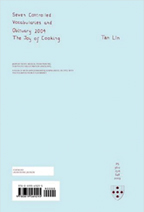 |
Tan Lin. Seven Controlled Vocabularies and Obituary 2004. The Joy of Cooking. Middletown, Conn.: Wesleyan University Press, 2010.
Wearing its Library of Congress Cataloguing-in-Publication Data on its cover like a title, Tan Lin’s Seven Controlled Vocabularies and Obituary 2004. The Joy of Cooking is a book of poetry in search of a format—or perhaps more accurately, in search of an operating system. At first, much of its content seems random and distantly appropriated, with the look and feel of metadata and/or marginalia. It also has an environmental, even ambient, quality that is able to prompt very different kinds of reading, simultaneously spanning disparate genres and media. (The title page offers a telling subtitle: Airport Novel Musical Poem Painting Theory Film Photo Landscape.) And in these different readings an inexhaustible book takes shape, one that offers an unexpected comfort in its wash of information and overlapping formats.
|